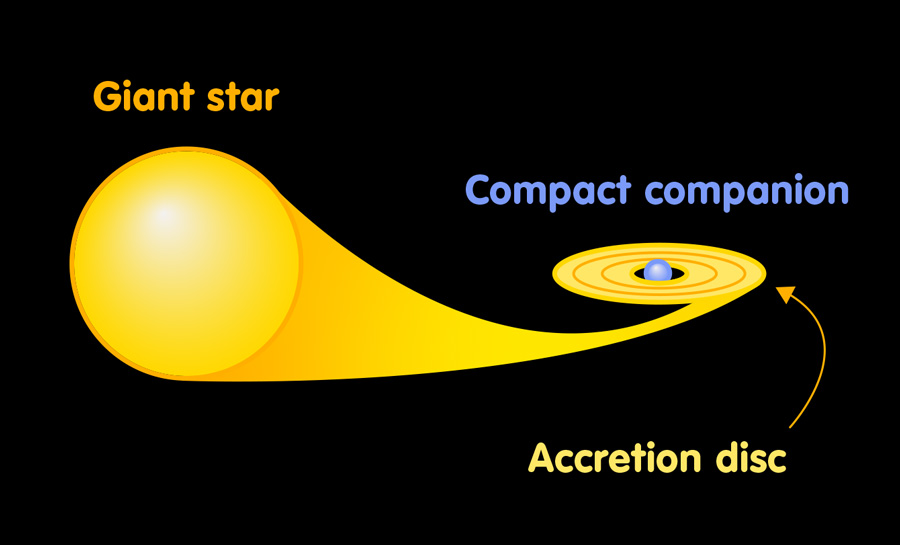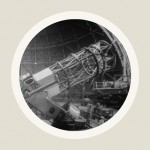Luminous disks: How black holes light up their surroundings
How the fact that black holes are very efficient in attracting surrounding matter leads to some of the most spectacularly luminous phenomena in the whole of the cosmos
An article by Andreas Müller
Gravity results in universal attraction between all masses. One possible consequence of this is accretion, the astrophysicists’ blanket term for processes in which a massive central object picks up (“accretes”) matter from its direct neighbourhood. Accretion causes the central object to become more massive, and thus ever better in picking up matter. As a first step towards understanding accretion, it is useful to take a look at a more general question: What are the possible outcomes when matter falls towards a central object?
Falling matter
If the central object is a solid body, matter can fall directly onto that body and come to a sudden stop. This would be an example of a “mechanical barrier” – the central object’s surface prevents matter from falling any further, just as the earth’s solid surface keeps us from falling right into the center of our home planet. If the central body is a black hole, matter can fall directly towards the black hole’s horizon and into the black hole, never to be seen again. In both cases, matter takes a straight plunge.
But this is by no means the only possibility – in fact, it is the exception rather than the rule. Usually, matter will be in motion even before it is close enough for the central object to exert a significant pull. Unless this motion is directed exactly towards the central object – a special case, and thus very rare – there will be a component of sideways motion, and if that component is large enough, the falling matter will not hit the central object, but go past it.
One possible outcome of such a near miss is an orbit on which the infalling mass passes close to the central objects before heading out into space, never to return (unbound orbit). Another is a closed (bound) orbit on which the infalling mass continues to move around the central object; well-known examples are the planets in our solar system on their orbits around the sun.
Another example of a near-miss orbit, this one somewhat more complicated, can be seen in the image below – a binary star system consisting of a giant star, shown on the left, and a compact companion star, on the right:

The giant star is so large that for some of the matter in its outer envelope, the gravitational pull of the compact companion is greater than that of the giant star itself. Matter is pulled towards the companion. However, that matter does not plunge directly onto the companion star because it has sufficient sideways motion to build up a so-called accretion disk. This disk made of stellar material orbits the companion star.
Angular momentum and the fate of matter in accretion disks
The fact that matter with sufficient sideways motion will miss the central object is due to what physicists call the conservation of angular momentum. When an object orbits a central mass under the influence of gravity, the laws of mechanics make a clear statement: for the orbiting object, the product of its mass, its distance to the central body and the velocity at which it moves around that body – this is, per definition, the object’s angular momentum – must remain constant over time. An orbiting planet cannot suddenly change its course and head straight into the sun. For that, its angular momentum would suddenly have to jump to zero, in defiance of the laws of physics. (More about the conservation of angular momentum can be found in the Spotlight topic What figure-skaters, planets, and neutron stars have in common.)
In the case of a planet, the conservation of angular momentum leads to a regular orbit. In the case of the binary star pictured above, it has a role to play as well: The giant star in the illustration is rotating slowly, and so does the matter contained in its outer regions. In consequence, this matter has non-zero angular momentum. This angular momentum is conserved as the matter particles fall towards the compact companion to form the accretion disk.
The situation in the accretion disk is significantly more complicated than for orbiting planets. The laws of mechanics decree that the total sum of all matter particles’ angular momenta cannot change over time, but it is perfectly permissible for one particle to transfer parts of its angular momentum to other particles. This is called angular momentum transport. For instance, this transport becomes important as soon as turbulence occurs. Turbulence is a natural phenomenon in dynamical plasmas and gases (as well as in fluids). The most efficient mechanism to re-distribute angular momentum involves plasma matter, in which the different particles influence each other via weak magnetic fields. The net result is a redistribution of angular momentum from the inner into the outer regions of the disk. During this process, the matter in the innermost regions manages to shed enough angular momentum to be able to fall onto (or into) the central object itself. In this way, more and more matter accretes onto the central object. Without angular momentum transfer, this growth by accretion would be impossible.
Luminous disks
The most effective collectors of matter are the most compact objects in the cosmos: black holes. They are perfect “spacetime traps” – nothing that falls into a black hole can ever escape, not even light. Therefore, black holes are indeed as black as their name indicates, and very difficult for astronomers to detect. However, the situation changes dramatically once a black hole is “fed” with matter from its vicinity – then, black holes can transform their surroundings into the brightest and most spectacular regions of the cosmos!
There are several ways for black holes to light up their cosmic neighbourhood. Some require very special circumstances, but one is universal wherever matter falls into a black hole: the production of thermal radiation. Matter falling towards a central object under the influence of gravity gets accelerated to higher and higher speeds, gaining more and more kinetic energy. But once a particle of infalling matter plunges into an accretion disk – and possibly earlier – the particle’s motion is disturbed. Due to frequent collisions between all the different particles, there are no well-defined simple orbits. Instead, the whole ensemble of particles is in chaotic motion. Such chaotic motion with eddies and instabilities – just as in a turbulent fluid – is commonplace within accretion disks. By definition, disordered microscopic particle motion is thermal motion, and as such directly related to temperature. As the infalling particles’ motion becomes chaotic, matter in the accretion disk is heated to very high temperatures. The maximum temperature in an accretion disk around a supermassive black hole a hundred times the mass of our sun will be around one million Kelvin and for the disk around a stellar black hole, it can be up to a factor hundred higher. By comparison, the temperature in the core of our sun amounts to about 15 million Kelvin.
In physics, wherever there is heat, there is thermal electromagnetic radiation. Every body emits thermal radiation – only a body with a temperature of absolute zero would not, but such bodies cannot exist (more information about thermal radiation can be found in the Spotlight topic Heat that meets the eye). As a body’s temperature increases, so does the energy emitted in the form of radiation. The temperature of an accretion disk around a black hole is high enough for the disk matter to emit large amounts of highly-energetic X-rays.
Matter falling towards a central object, forming an accretion disk, represents an eminently efficient way to produce radiation from other forms of energy (in this case gravitational energy). It is roughly 30 times more efficient than nuclear fusion, the energy conversion mechanism responsible for the luminosity of our sun and other stars.
As of yet, no astronomer has managed to take detailed images of the accretion flow onto a central black hole – that would require a higher resolution than current telescopes can provide. Instead, astrophysicists have indirect ways of testing their assumptions about what happens near such black hole: From computer simulations, they can predict the spectra of accretion disks – the way the radiation energy is distributed among the different frequencies. These spectra carry a clear imprint of the local conditions – a strong gravitational redshift tells of the central object’s compactness; systematic Doppler shifts record how matter moves at nearly the speed of light in the surrounding disk. Whenever observations show the mass concentrated in the innermost region to be high enough – with no luminous object visible at that particular spot – there is a strong likelihood for the central object to be a black hole.
From this list of characteristic properties, astronomers have a clear notion of what to look for, and, as it turns out, there are indeed objects in the night sky with exactly the required properties. In fact, for a number of candidate objects, the match between prediction and observation is quite impressive. Thus, it appears that our universe does contain black holes accreting matter. (More information about the astronomical objects in question can be found in the Spotlight topic Active black holes: Ultra-hot cosmic beacons.)
Further Information
Relativistic background information for this Spotlight topic can be found in Elementary Einstein, in particular in the chapter Black holes & Co..
Related Spotlights on relativity can be found in the category black holes.
Colophon
is a physicist and science writer.
Citation
Cite this article as:
Andreas Müller, “Luminous disks: How black holes light up their surroundings” in: Einstein Online Band 02 (2006), 02-1010










